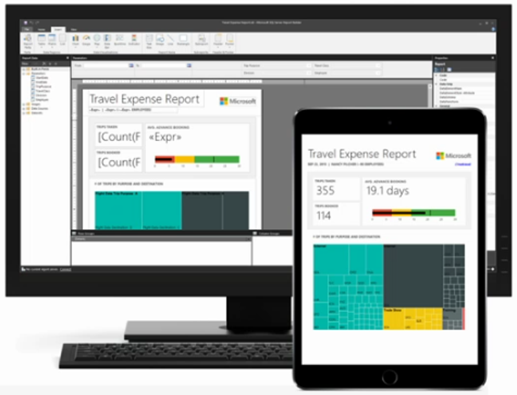SSRS应用理解与实现
SSRS应用与理解
前言
很多企业的管理系统,像ERP、CRM等,都会有统计报表或财务收据的部分。目前市面上应用的比较火的PC报表产品有FineReport、葡萄城、PowerBI,不过它们都是些成熟的可直接用的产品,今天介绍的是一套微软的报表服务以及工具SSRS(ReportingSerivces),它有很强的可扩展性,可以集成到自己的任何程序当中去,刚好我们公司用到了这项技术,所以写写自己的理解。
什么叫SSRS
官网定义:
SQL Server Reporting Services (SSRS) 提供了一系列本地工具和服务,用于创建、部署和管理移动和分页报表。
主要是工具和服务,说明产品本身已经很完善了,但我们可以基于它这一套做成自己的报表系统。

SSRS成员介绍
ReportBuilder
报表生成器,可创建报表,连接报表服务器之后将报表上传至报表服务器数据库
ReportViewer
报表预览控件,支持本地模式和远程模式。项目引用后,根据所需要实现对应的属性方法后,控件统一执行渲染。
SQL Server ReportingServices
Windows服务,提供远程模式的报表渲染服务。在安装数据库功能中可勾选此项进行安装。SQL 2017及以后可以用独立工具安装此服务。
Report Server Configuration Manager
服务配置管理器,用来管理维护服务地址,端口,报表数据库等信息的操作界面工具。
SSRS应用原理与架构

1、报表生成器制作报表并通过ReportingService服务上传至报表服务器数据库。
2、ReportViewer控件通过设置远程服务地址以及报表目录,参数,并通过ReportingServices服务从报表服务器数据库获取报表信息并执行。(或通过本地模式)
ReportViewer控件使用方法
前提是我们在项目中引用了Microsoft.ReportViewer.WebForms.dll 并在Aspx页面中定义了该控件
<rsweb:ReportViewer ID="ReportViewer1" runat="server" Height="386px" Width="1427px"></rsweb:ReportViewer>
后台代码
Microsoft.Reporting.WebForms.ReportViewer _ReportViewer;
protected void Page_Load(object sender, EventArgs e)
{
_ReportViewer = this.ReportViewer1;
}
控件它本身有两种模式,一种是服务器模式,一种是本地模式。
服务器模式需要依靠本地或服务器的ReportingServices服务,依赖服务进行报表的渲染。优点:耗服务端资源并且性能不错 缺点:部署复杂
本地模式只需要用到控件本身,相关属性自己程序处理后赋值给控件即可。优点:部署简单,使用方便 缺点:大数据量的报表非常耗客户端浏览器的内存
//服务器模式
protected void Button2_Click(object sender, EventArgs e)
{
ReportViewer1.Reset();
ReportViewer1.ProcessingMode = ProcessingMode.Remote;
ReportViewer1.Visible = true;
//引擎数据库中报表路径
ReportViewer1.ServerReport.ReportPath = "/报表项目2/Report1";
ReportViewer1.ServerReport.DisplayName = "示例报表";
//ReportingService服务地址
ReportViewer1.ServerReport.ReportServerUrl = new Uri("http://wh-pc-tians66/ReportServer");
//身份验证
ReportViewer1.ShowCredentialPrompts = false;
ReportViewer1.ServerReport.ReportServerCredentials = new MyCredentials("sa", "666666",null);
//Export("EXCEL");
}
//本地模式
protected void Button1_Click(object sender, EventArgs e)
{
ReportViewer1.Reset();
ReportViewer1.ProcessingMode = ProcessingMode.Local;
ReportViewer1.Visible = true;
//报表预览指定以流的方式或路径方式
//ReportViewer1.LocalReport.LoadReportDefinition(stream);
ReportViewer1.LocalReport.ReportPath = @"F:\Demo\ReportViewer\rdl\Report1.rdl";
ReportViewer1.LocalReport.DisplayName = "示例报表";
ReportViewer1.LocalReport.DataSources.Clear();
//数据集结果
ReportViewer1.LocalReport.DataSources.Add(new Microsoft.Reporting.WebForms.ReportDataSource("DataSet1", GetDataTable()));
ReportViewer1.LocalReport.Refresh();
//Export("EXCEL");
}
}
当页面加载完成或通过其他动作可以触发,ReportViewer的展示报表。
报表文件解析
通过制作器生成的报表,其本身是一种带了丰富的报表元素xml文件。微软定义为后缀名为RDL的XML文件,根据不同元素和节点构建完整报表文件。
如:
表格-Table
矩形-Tablix
文本框-Textbox
单位-ReportUnitType


可扩展部分
本地模式:
如果项目中只考虑本地模式,那么可扩展部分就是ReportViewer的控件集成,它也支持集成到.NET CORE项目中。并使用微软的ReportBuilder制作报表皆可,或自己操作XML文件生成简单报表。
远程模式:
如果项目中采用服务器模式,那么可扩展部分除了本地模式中的两部分外,还需要掌握自己程序与远程服务ReportingService进行交互的方法,它本身提供了Soap Api接口供调用。
(SOAP 在 Reporting Services 中的角色 - SQL Server Reporting Services (SSRS) |微软文档 (microsoft.com))





【推荐】国内首个AI IDE,深度理解中文开发场景,立即下载体验Trae
【推荐】编程新体验,更懂你的AI,立即体验豆包MarsCode编程助手
【推荐】抖音旗下AI助手豆包,你的智能百科全书,全免费不限次数
【推荐】轻量又高性能的 SSH 工具 IShell:AI 加持,快人一步
· 分享一个免费、快速、无限量使用的满血 DeepSeek R1 模型,支持深度思考和联网搜索!
· 基于 Docker 搭建 FRP 内网穿透开源项目(很简单哒)
· ollama系列01:轻松3步本地部署deepseek,普通电脑可用
· 25岁的心里话
· 按钮权限的设计及实现